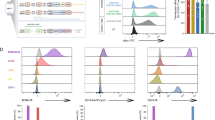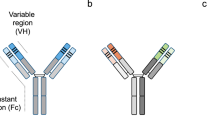Abstract
A bispecific antibody directed to T and B cells (CD3×CD19 bsAb) was daily infused intravenously in escalating doses from 10 μg up to 5 mg in three patients with chemotherapy-resistant non-Hodgkin lymphoma; in this way we aimed to activate T cells to kill the malignant B cells. Only limited toxicity was observed, consisting of moderate fever preceded by chills or shivers and mild thrombocytopenia. No human anti-(mouse Ig) antibodies were found. Pharmacokinetics showed at 1/2 of 10.5 h with peak levels of 200–300 ng/ml after infusion of 2.5 mg bsAb. bsAb in serum was functionally active in vitro. After bsAb infusion a rise in serum tumour necrosis factor α was observed, accompanied by an increase in soluble CD8 and to some extent in soluble interleukin-2 receptor (IL-2R), but not in interferon γ, IL-4 or soluble CD4. No evidence was found for monocyte activation (no increases in IL-6, IL-8 or IL-1ß in serum). No gross changess in histology or number of IL-2R+, CD4+ or CD8+ cells were found in the lymph nodes after therapy, but one patient showed activated CD8+ T cells within the tumour nodules. In conclusion, after intravenously administered CD3×CD19 bsAb only moderate toxicity was found, probably due to CD8+ T cell activation and cytokine release, without CD4+ T cell activation.
Similar content being viewed by others
References
Fisher RI, Gaynor ER, Dahlberg S, Oken MM, Grogan TM, Mize EM, Glick JH, Coltman CA, Miller TP (1993) Comparison of a standard regimen (CHOP) with three intensive chemotherapy regimens for advanced non-Hodgkin's lymphoma. N Engl J Med 328:1002
Segal DM, Qian JH, Mezzanzanica D, Garrido MA, Titus JA, George AJT, Jost CR, Perez P, Wunderlich JR (1992) Targeting of anti-tumor responses with Bispecific antibodies. Immunobiology 185:390
Beun GDM, Velde CJH van de, Fleuren GJ (1994) T-cell based cancer immunotherapy: direct or redirect tumor-cell recognition. Immunol Today 15:11
Nitta T, Sato K, Yagita H, Okumura K, Ishii S (1990) Preliminary trial of specific targeting therapy against malignant glioma. Lancet 335:368
Bolhuis RLH, Lamers CHJ, Goey SH, Eggermont AMM, Trimbos JBMZ, Stoter G, Lanzavecchia A, Re E de, Miotti S, Raspagliesi F, Rivoltini L, Colnaghi MI (1992) Adoptive immunotherapy of ovarian carcinoma with Bs-Mab-targeted lymphocytes: a multi-center study. Int J Cancer Suppl 7:78
Tibben JG, Boerman OC, Claessens RAMJ (1993) Cytokine release in an ovarian carcinoma patient following intravenous administration of bispecific antibody OC/TR F(ab)2. J Natl Cancer Inst 85:1003
Uckun FM, Ledbetter JA (1988) Immunobiologic differences between normal and leukemic human B-cell precursors. Proc Natl Ac Sci USA 85:8603
Haagen IA, Griend R van de, Clark M, Geerars A, Bast B, Gast GC de (1992) Killing of human leukaemia/lymphoma B cells by activated cytotoxic T lymphocytes in the presence of a bispecific monoclonal antibody (αCD3/αCD19). Clin Exp Immunol 90:368
Haagen IA, Geerars AJ, Lau WB de, Clark MR, Griend RJ van de, Bast BJEG, Gast GC de (1994) Killing of autologous Blineage malignancy using CD3×CD19 bispecific monoclonal antibody in end stage leukemia and lymphoma. Blood 84:556
Haagen IA, Lau WBM de, Bast BJEG, Geerars AJG, Clark MR, GAst GC de (1994) Unprimed CD4+ and CD8+ T cells can be rapidly activated by a CD3×CD19 bispecific antibody to proliferate and become cytotoxic. Cancer Immunol Immunother 39:391
Demanet C, Brissinck J, Mechelen Mv, Loe O, Thielemans K (1991) Treatment of murine B cell lymphoma with bispecific monoclonal antibodies (anit-idiotype×anti-CD3). J Immunol 147:1091
Brissinck J, Demanet C, Moser M, Leo O, Thielemans K (1991) Treatment of mice bearing BCL1 lymphoma with bispecific antibodies. J Immunol 147:4019–4026
Weiner GJ, Hillstrom JR (1991) Bispecific anti-idiotype/anti-CD3 antibody therapy of murine B cell lymphoma. J Immunol 147:4035
Clark MR, Waldmann H (1987) T-cell killing of target cells induced by hybrid antibodies: comparison of two bispecific monoclonal antibodies. J Natl Cancer Inst 79:1393
Clark MR, Bindon C, Dyer M, Friend P, Hale G, Cobbold R, Calne H, Waldmann H (1989) The improved lytic function and in vivo efficacy of monovalent monoclonal CD3 antibodies. Eur J Immunol 19:381
Vroom TM, Scholte G, Ossendorp F, Borst J (1991) Tissue distribution of human λδ T cells: no evidence for general epithelial tropism. J Clin Pathol 44:1012
Hekman A, Honselaar A, Vuist WMJ, Sein JJ, Rodenhuis S, Bokkel Huinink WW ten, Somers R, Rumke Ph, Melief CJM (1991) Initial experience with treatment of human B cell lymphoma with anti-CD19 monoclonal antibody. Cancer Immunol Immunother 32:364
Tomkinson BE, Brown MC, Ip SH, Carrabis S, Sullivan JL (1989) Soluble CD8 during T cell activation. J Immunol 142:224
Norment AM, Lonberg N, Lacy E, Littman DR (1989) Alternatively spliced mRNA encodes a secreted form of human CD8a. Characterization of the human CD8a gene. J Immunol 142:3312
Robb RJ, Kutny RM (1987) Structure function relationships for the IL-2 receptor system. IV. Analysis of the sequence and ligand-binding properties of soluble Tac protein. J Immunol 139:855
Huizinga TWG, Van der Schoot CE, Jost C, Klaassen R, Kleijer M, Von dem Borne AEGK, Roos D, Tetteroo PAT (1988) The PI-linked receptor FcRIII is released on stimulation of neutrophils. Nature 333:667
Kurane I, Innis BL, Nimmannitya S, Nisalak A, Meager A, Janus J, Ennis FA (1991) Activation of T lymphocytes in Dengue virus infections. J Clin Invest 88:1473
Sawada S, Sugai A, Lyma S, Takei M, Paredas E, Hayama T, Nishinarita S, Hosokawa Y, Horie T, Obara T (1992) Increased soluble CD4 and decreased soluble CD8 molecules in patients with Sjögren's syndrome. Am J Med 92:134
Symons JA, McCulloch JF, Wood NC, Duff GW (1991) Soluble CD4 in patients with rheumatoid arthritis and osteoarthritis. Clin Immunol Immunopathol 60:72
Beguin Y, Lapertz S, De Groote D, Igot D, Malaise M, Fillet G (1993) Soluble CD23 and other receptors (CD4, CD8, CD25, CD71) in serum of patients with chronic lymphocytic leukemia. Leukemia 7:2019
Krutmann J, Kirnbauer R, Köck A, Schwarz T, Schöpf E, May LT, Sehgal PB, Luger TA (1990) Cross-linking Fc receptors on monocytes triggers IL-6 production: role in anti-CD3-induced T cell activation. J Immunol 145:1337
Yoshimura TY, Matsushima K, Tanaka S, Robinson EA, Appella E, Oppenheim JJ, Leonard EJ (1987) Purification of a human monocyte-derived neutrophil chemotactic factor that has peptide sequence similarity to other host defense cytokines. Proc Natl Acad Sci USA 84:9233
Peters PM, Ortaldo JR, Shalaby MR, Svedersky LP, Nedwin GE, Bringman TS, Hass PE, Aggarwal BB, Herberman RB, Goeddel DV, Palladino MA (1986) Natural killer-sensitive targets stimulate production of TNF-α but not TNF-β (lymphotoxin) by highly purified human peripheral blood large granular lymphocytes. J Immunol 137:2592
Haagen I-A, Geerars AJG, De Lau WBM, Bast EJEG, de Gast GC (1995) The efficacy of CD3×CD19 bsAb in a clonogenic assay; the effect of repeated addition of bispecific antibody and IL-2. Blood (in press)
Mueller DL, Jenkins MK, Schwartz RH (1989) Clonal expansion versus functional clonal inactivation: a costimulatory signalling pathway determines the outcome of T cell antigen receptor occupancy. Annu Rev Immunol 7:445
Guinan EC, Gribben JG, Boussiotis VA, Freeman GJ, Nadler LM (1994) Pivotal role of the B7:CD28 pathway in transplantation tolerance and tumor immunity. Blood 84:3261
June CH, Ledbetter JA, Linsley PS, Thompson CB (1990) Role of the CD28 receptor in T-cell activation. Immunol Today 11:211
Bohlen H, Hopff T, Manzke O, Engert A, Kube D, Wickramanayake PD, Diehl V, Tesch H (1993) Lysis of malignant B cells from patients with B-chronic lymphocytic leukemia by autologous T cells activated with CD3×CD19 bispecific antibodies in combination with bivalent CD28 antibodies. Blood 82:1803
Bohlen H, Manzke O, Patel B, Moldenhauer G, Dörken B, Fliedner V von, Diehl V, Tesch (1993) Cytolysis of leukemic B-cells by T-cells activated via two bispecific antibodies. Cancer Res 53:4310
Weiner GJ (1992) Bispecific IgG and IL-2 therapy of a syngenic B-cell lymphoma in immunocompetent mice. Int J Cancer 7:63
Nakajima F, Khanna A, Xu G, Lagman M, Haschemeyer R, Mouradian J, Wang JC, Stenzel KH, Rubin AL, Suthanthiran M (1994) Immunotherapy with anti-CD3 monoclonal antibodies and recombinant interleukin 2: stimulation of molecular programs of cytotoxic killer cells and induction of tumor regression. Proc Natl Acad Sci USA 91:7889
Kroesen BJ, Buter J, Sleijfer DTh, Jansen RAJ, Graaf WTA van der, The TH, Leij L de, Mulder NH (1994) Phase I study of intravenously applied bispecific antibody in renal cell cancer patients receiving subcutaneous interleukin 2. Br J Caner 70:652
Author information
Authors and Affiliations
Rights and permissions
About this article
Cite this article
de Gast, G.C., Haagen, IA., van Houten, A.A. et al. CD8 T cell activation after intravenous administration of CD3×CD19 bispecific antibody in patients with non-Hodgkin lymphoma. Cancer Immunol Immunother 40, 390–396 (1995). https://doi.org/10.1007/BF01525390
Received:
Accepted:
Issue Date:
DOI: https://doi.org/10.1007/BF01525390




